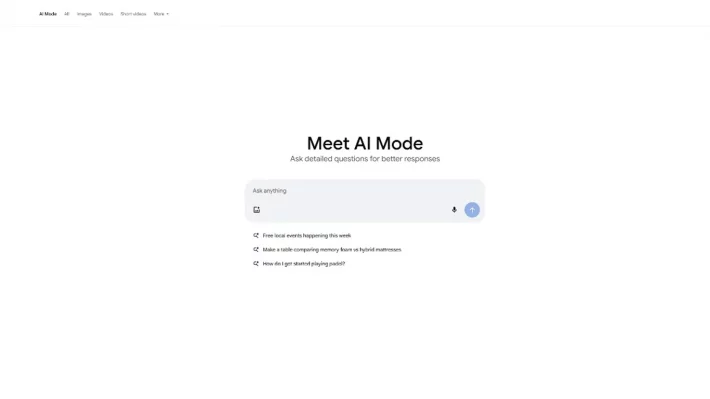A lot of people thought that Google’s AI Mode (also called AI Overviews) would kill off smaller AI search engines like Perplexity. Google has most of the search market and can add new features for billions of people with just one update.
Google AI Mode did not kill Perplexity. It changed how search engines work. Google now gives quick, short answers and keeps people using its tools. On the other hand, perplexity stands out by giving clear answers and always providing trusted sources. It also has its own browser, called Comet, which helps you search more effectively.
In this blog post, we’ll talk about how Google AI Mode works, what makes Perplexity different. We will also do a compression comparison between Google AI mode vs. Perplexity.
What is Google AI Mode?
Google AI Mode is an advanced feature in Google Search that uses the capabilities of Gemini 2.5 to provide more insightful and comprehensive answers to your queries.It uses smart thinking and can understand questions asked in different ways, like typing, talking, or even through photos. AI Mode helps you get clear and precise answers, even for the toughest questions.
Features of Google AI Mode
Ask Anything: Google AI Mode can help you with anything from figuring out a tough subject to getting specific suggestions to deciding between two products. AI Mode will give you useful information in a way that’s easy to understand if you just ask.
Multimodal Input: AI Mode lets you ask questions in a number of ways, such as by typing, speaking, taking a picture, or uploading one. This helps AI Mode really understand your question, no matter how you ask it.
Research Made Easy: AI Mode can help you do research by organizing information and giving you simple answers to your questions, even if they are very specific. It also has links to more information on the web, which makes research easier and faster.
Deep Search: AI Mode has an advanced tool called Deep Search that is powered by the Gemini 2.5 Pro model. It gives you more detailed answers. In just a few minutes, this tool will search hundreds of websites and put together a detailed, well-cited report. Deep Search is available to Google AI Labs members and gives very detailed and accurate results.
Continuous Improvement: AI Mode is still changing, which is a sign of continuous improvement. Your feedback as a user helps make things better. Users should know, though, that it is still in testing and may make mistakes from time to time.
How Google AI Mode works
The goal of Google AI Mode is to make searching easier and more natural. It uses advanced AI technology called Gemini 2.5 to understand not just what you type, but also what you say or even the photos you upload. This makes it possible for Google to give you more accurate and complete answers in a way that feels natural. For instance, if you ask a hard question, AI Mode will break it down into simple answers.
It can also make suggestions and lead you to more information if you need it. The tool learns from every interaction, so as time goes on, it gets better at giving you correct answers. AI Mode makes it easy to find the information you need, whether you’re just looking for quick facts or want to do more in-depth research.
Google AI mode vs. Perplexity

Below we have mentioned some features about Google AI mode and distraction. Check out these features and learn about them.
| Feature | Google AI Mode | Perplexity AI |
| Platform Type | Built into Google Search | Individual AI answer engine |
| Interface | Familiar Google layout, can be cluttered with ads | Clean and focused, minimal distractions |
| Best For | Quick facts, local searches, shopping | Quick facts, academic, technical, and detailed queries |
| Source Citation | Often lacks clear source links | Almost every statement is cited with links to sources |
| Depth of Answer | Basic summaries, links for more | In-depth responses with “Deep Research” mode |
| Special Features | Integrates with Google Maps, Images, and tools | Copilot for follow-ups, Focus mode, file upload (Pro) |
| Search Speed | Fast and responsive | Slightly slower but more thorough |
| Local Results | Strong with Maps, ratings, reviews, recipe cards | Limited visual support, weak on geo-specific data |
| Free Access | Yes, completely free | Free plan with limitations; Pro plan at $20/month |
| Real-Life Use Cases | Great for cafes, quick headlines, recipes | Best for essays, reports, deep tech or medical info |
What makes Perplexity different from Google AI Mode
Perplexity AI and Google AI Mode are both great at what they do, but they are good at different things.
Google AI Mode: This is for quick, everyday questions. It’s great for things like looking up local businesses, getting the weather, or answering simple questions. It has useful integrations like Google Maps, Reviews, and the Knowledge Graph that give you quick, useful information. It’s great for everyday use or when you need something right away.
Perplexity AI: This tool is better for research-based questions that need more depth. It’s great for complicated, technical, or academic subjects. Focus mode and other features let users narrow their search results to certain sources, such as YouTube, Reddit, or academic papers. This makes it a great choice for in-depth research. With the Pro plan, you can even upload files, like PDFs, for more in-depth analysis.
Summary: For everyday, quick answers, Google AI Mode is best. For more detailed, research-heavy searches, Perplexity AI offers advanced tools to dig deeper into complex topics.
Conclusion
Google AI Mode has not “killed” Perplexity AI. Google AI Mode is great for quick, everyday questions and works well with Google’s tools for local searches and simple answers. However, Perplexity AI is still the best for in-depth research. It is made for complicated, technical, or academic questions and gives detailed, well-cited answers.
In short, Google AI Mode is great for getting quick answers, but Perplexity AI is still the best at giving in-depth, well-researched information for more complicated questions. Both meet different needs, which makes them still useful in today’s search landscape.






